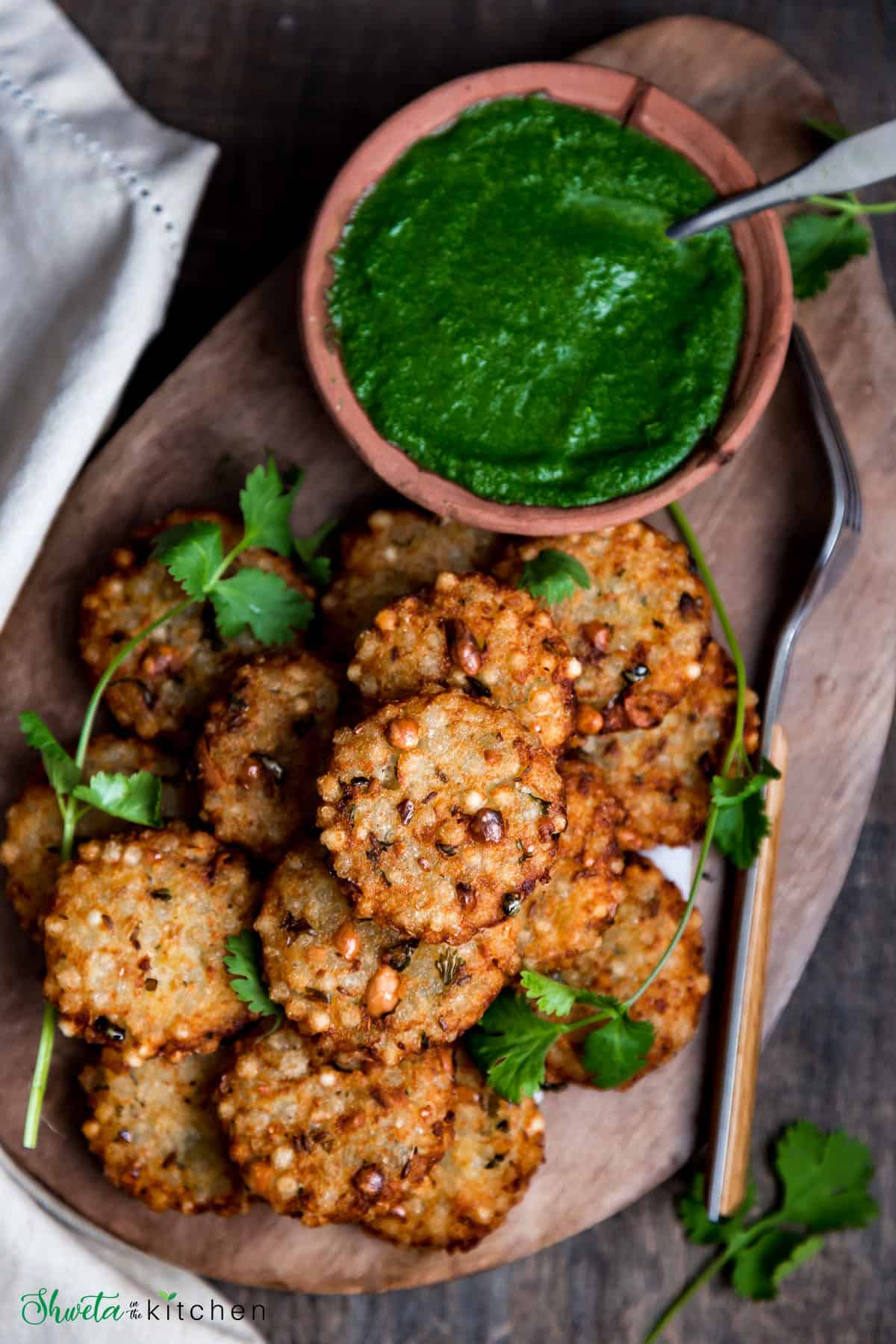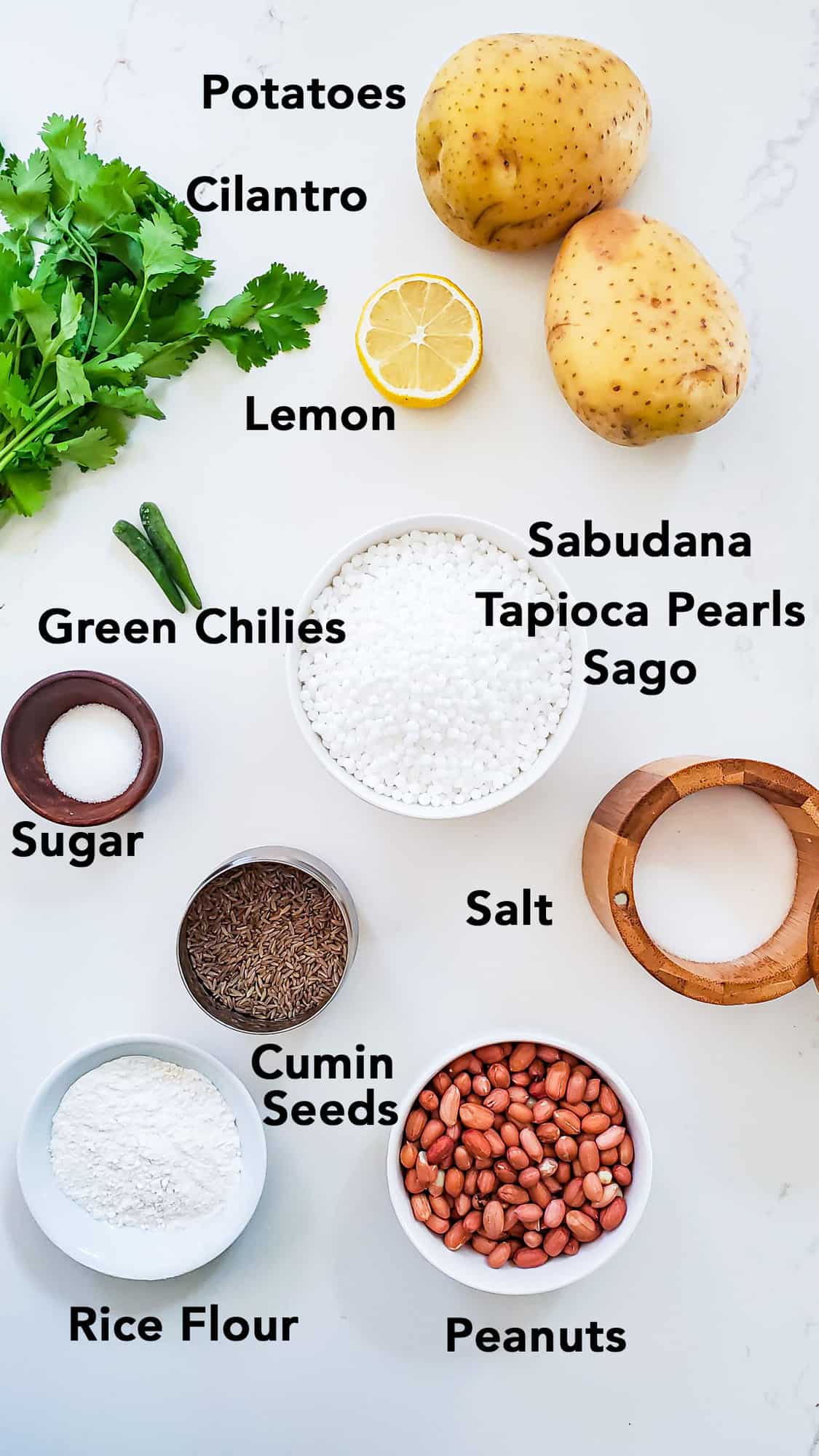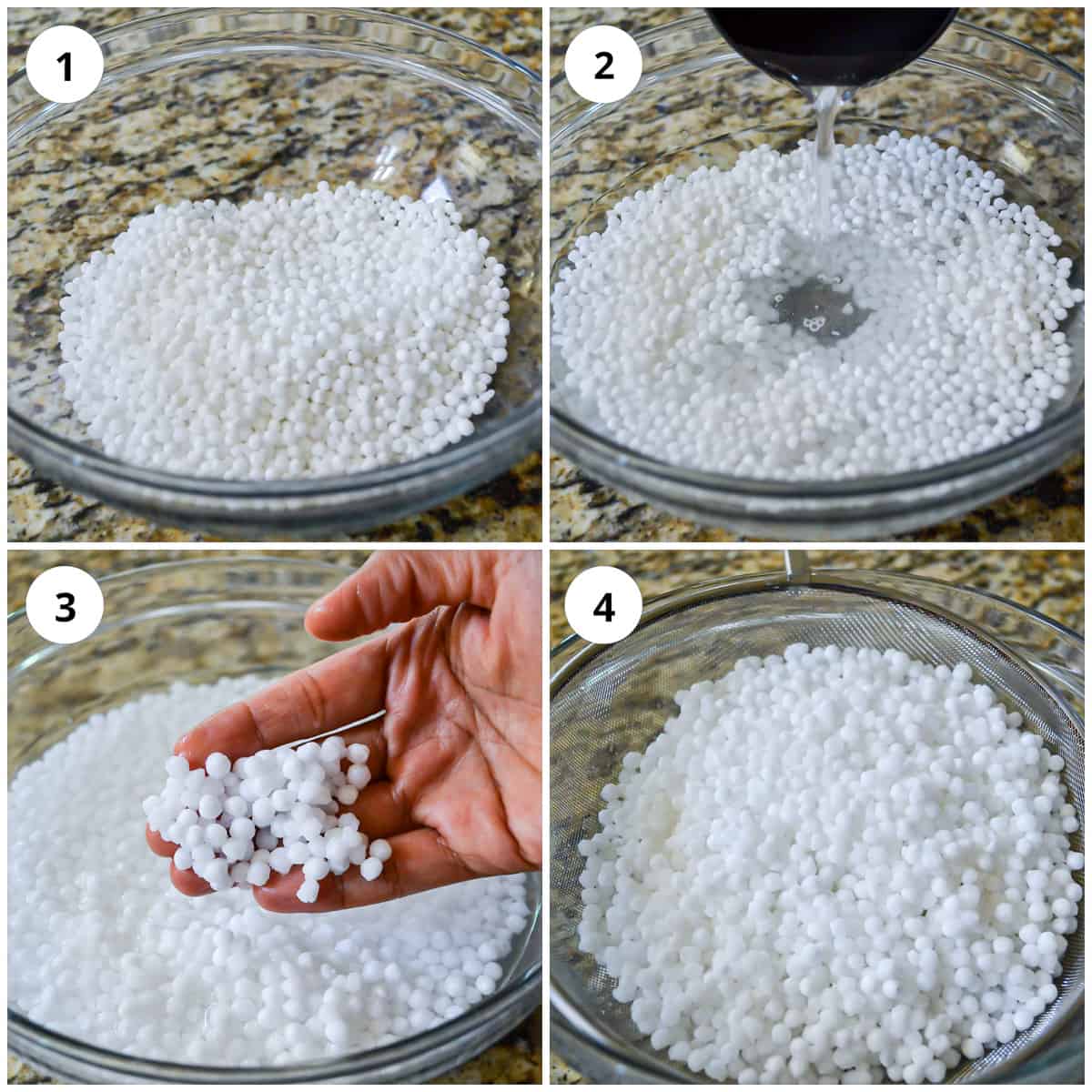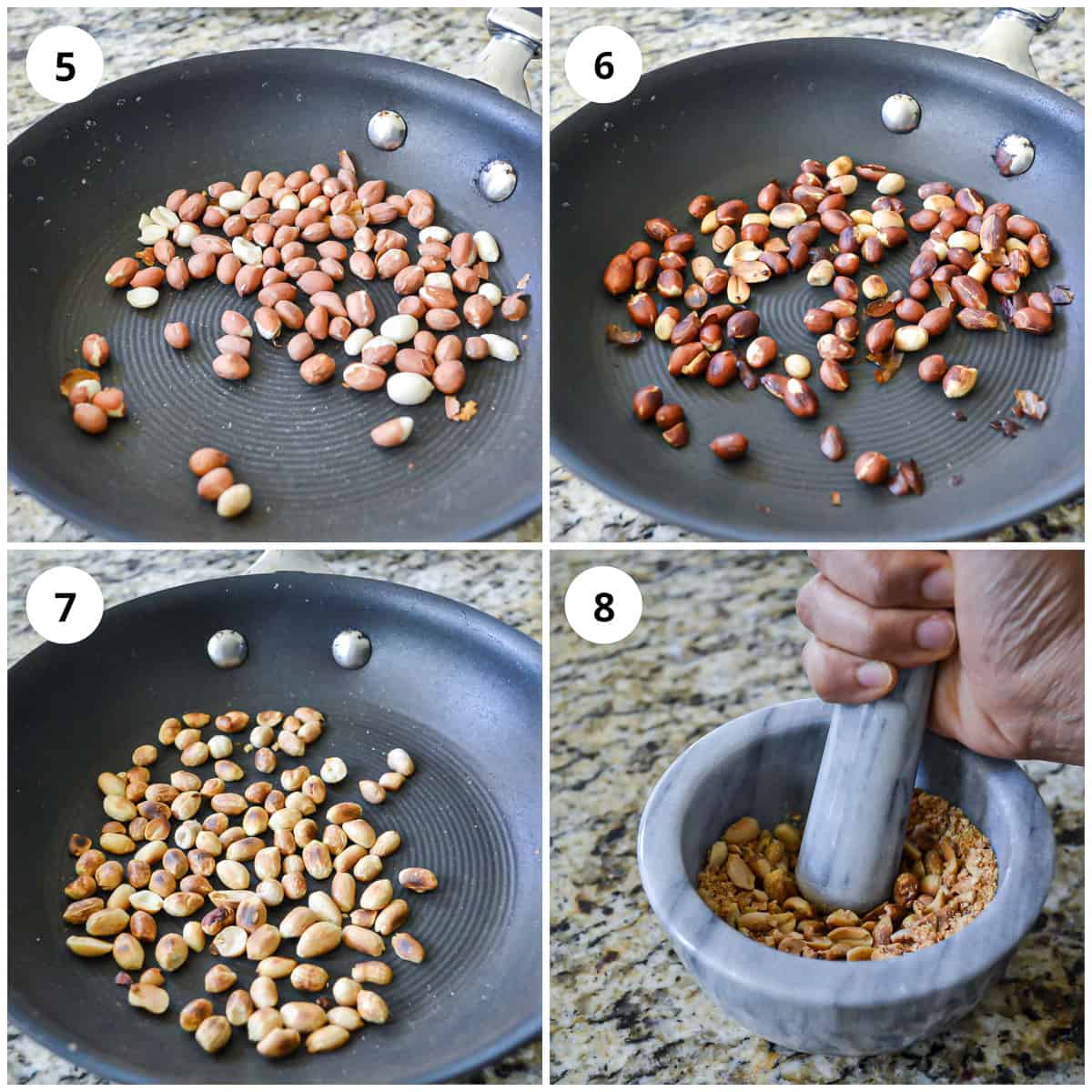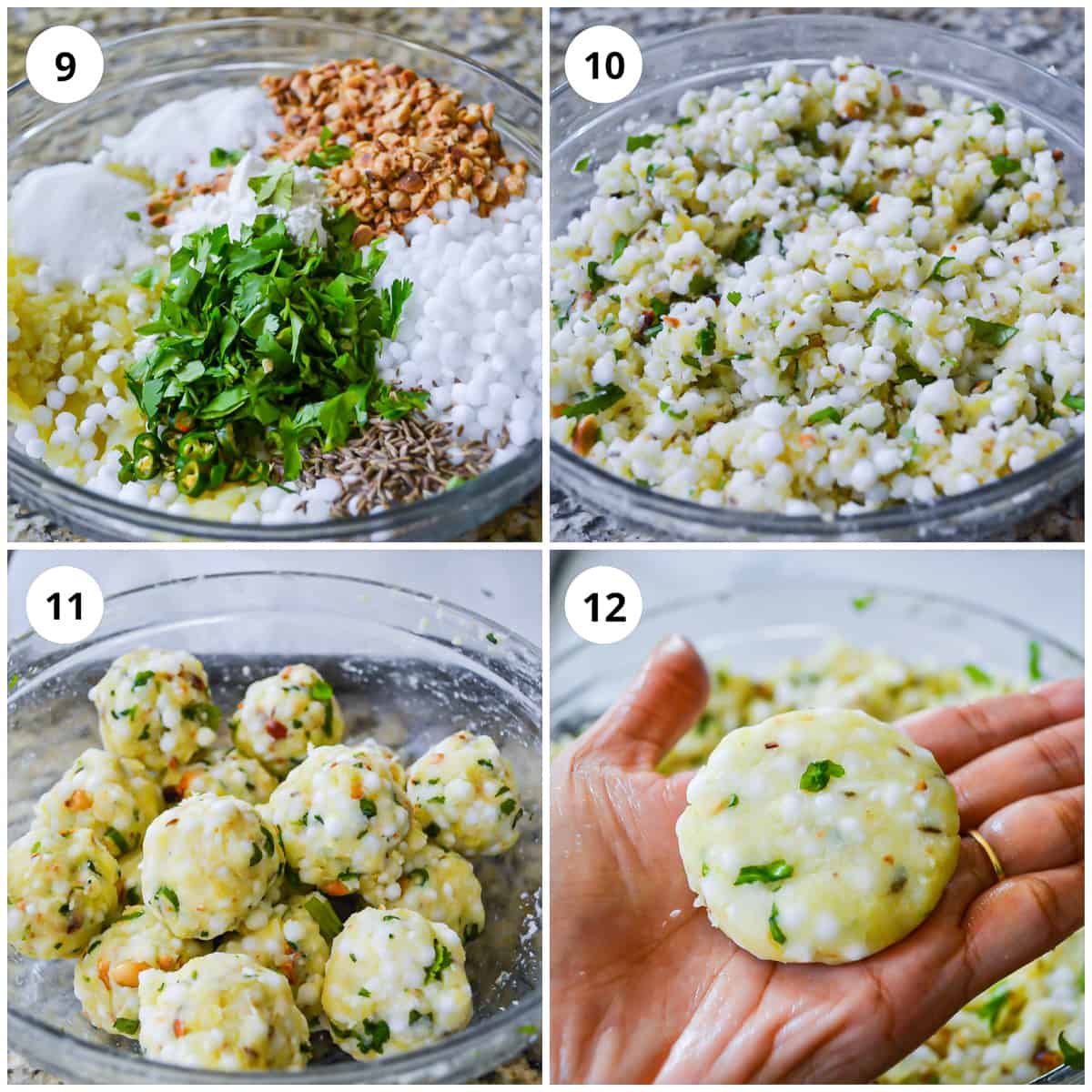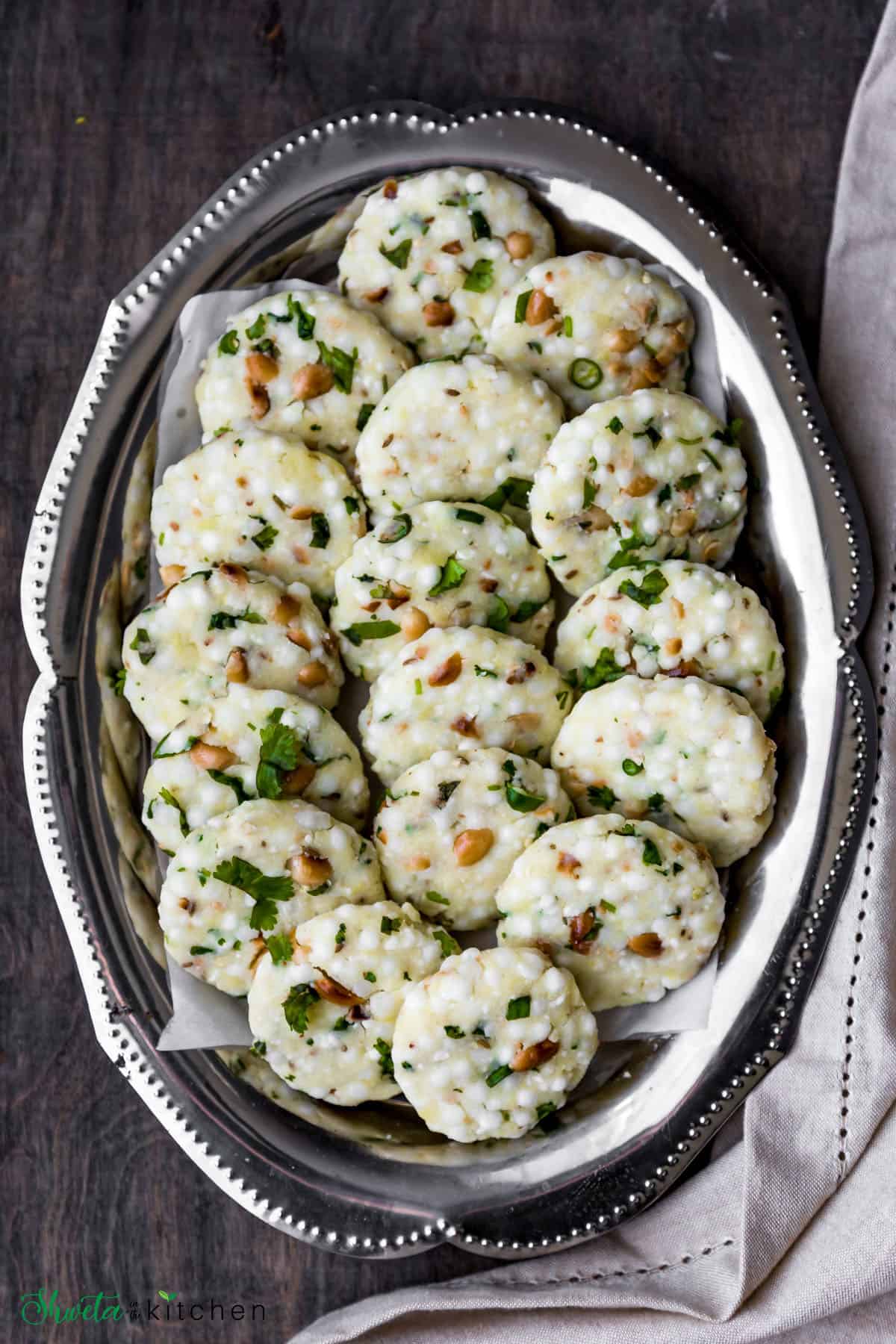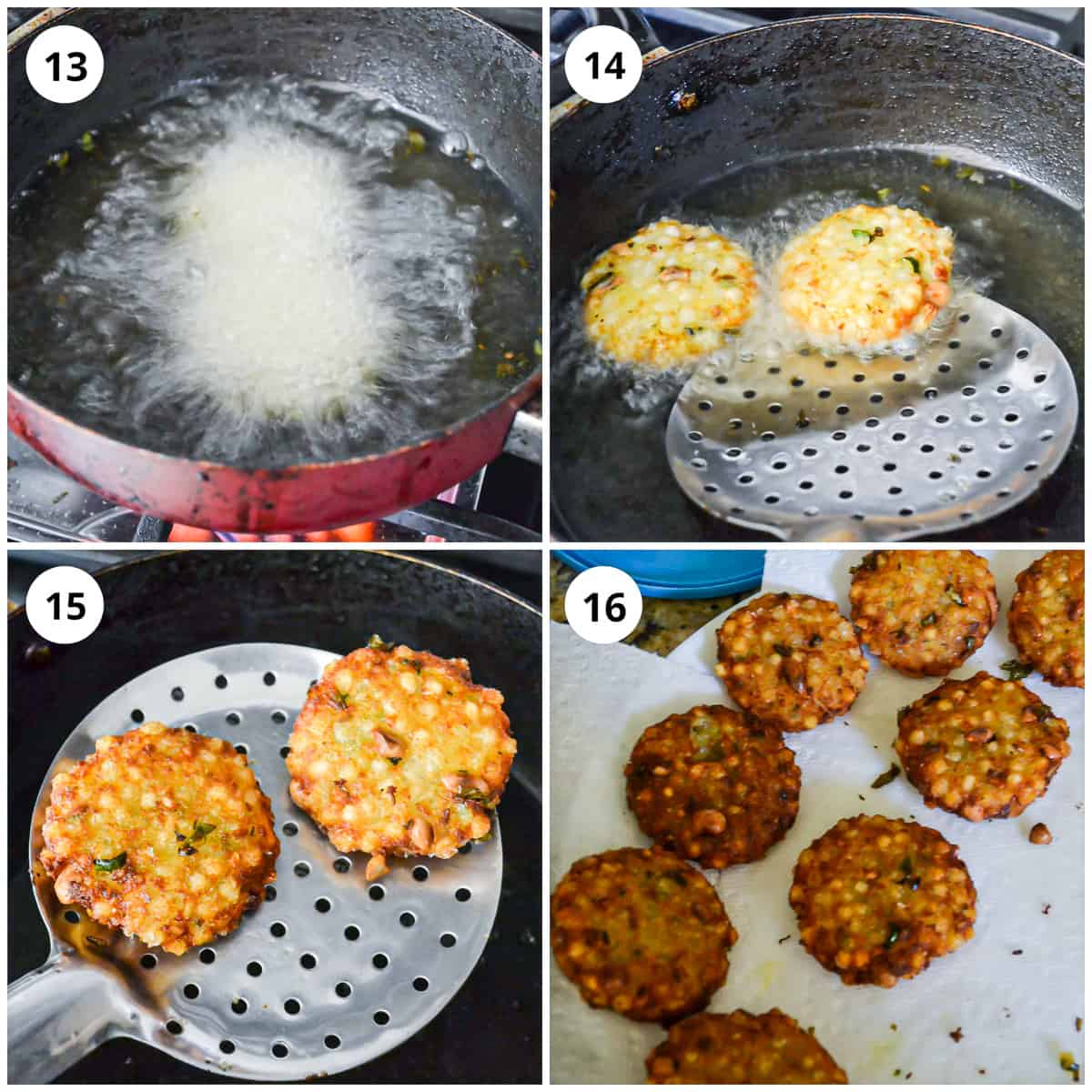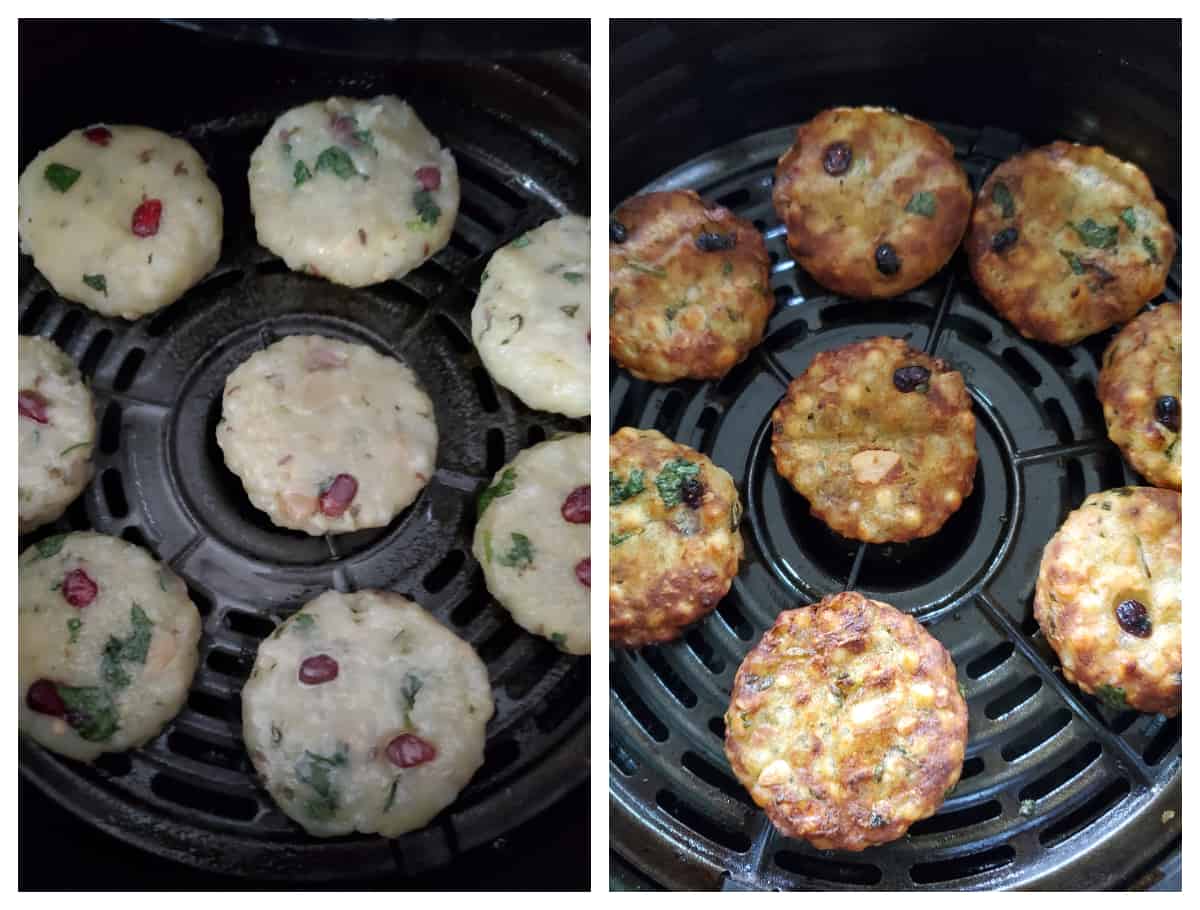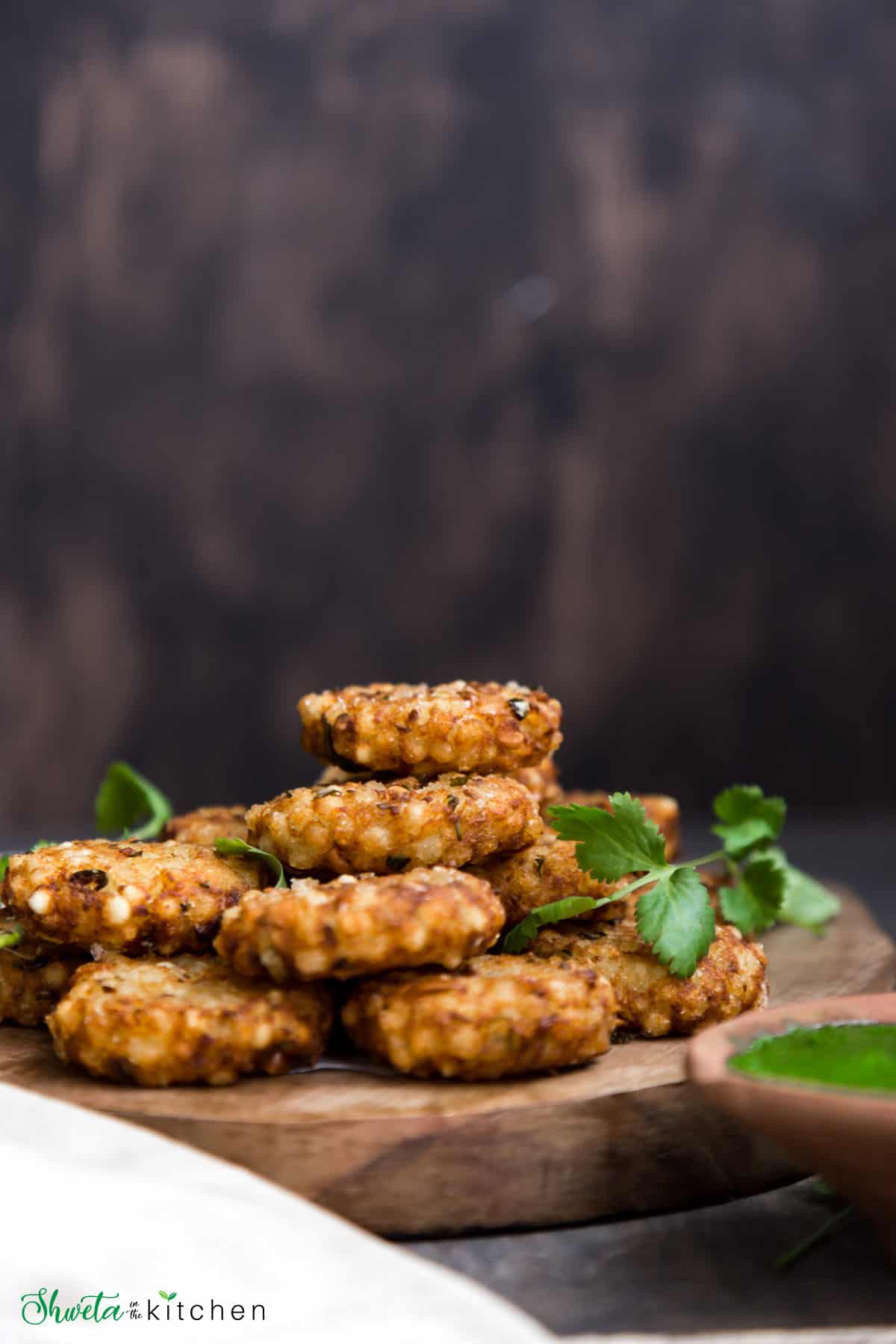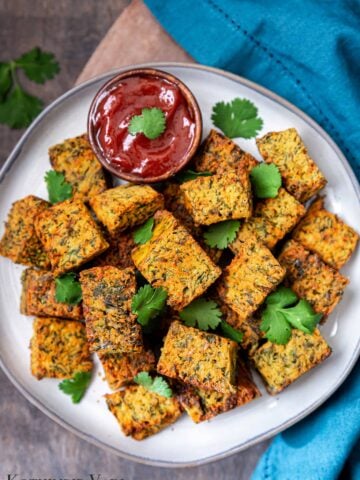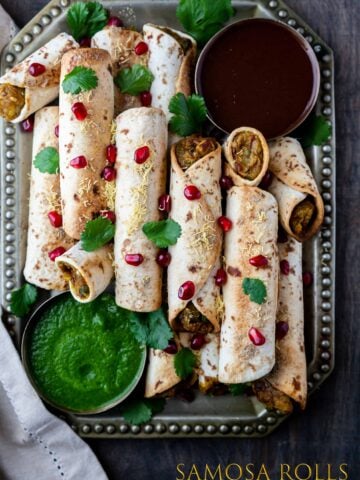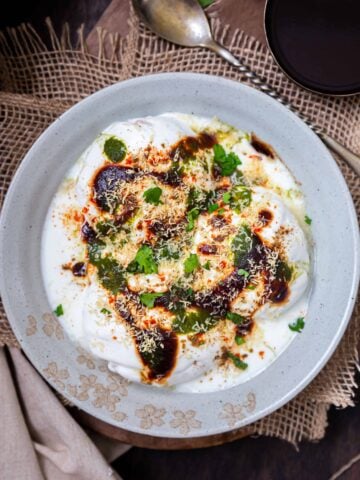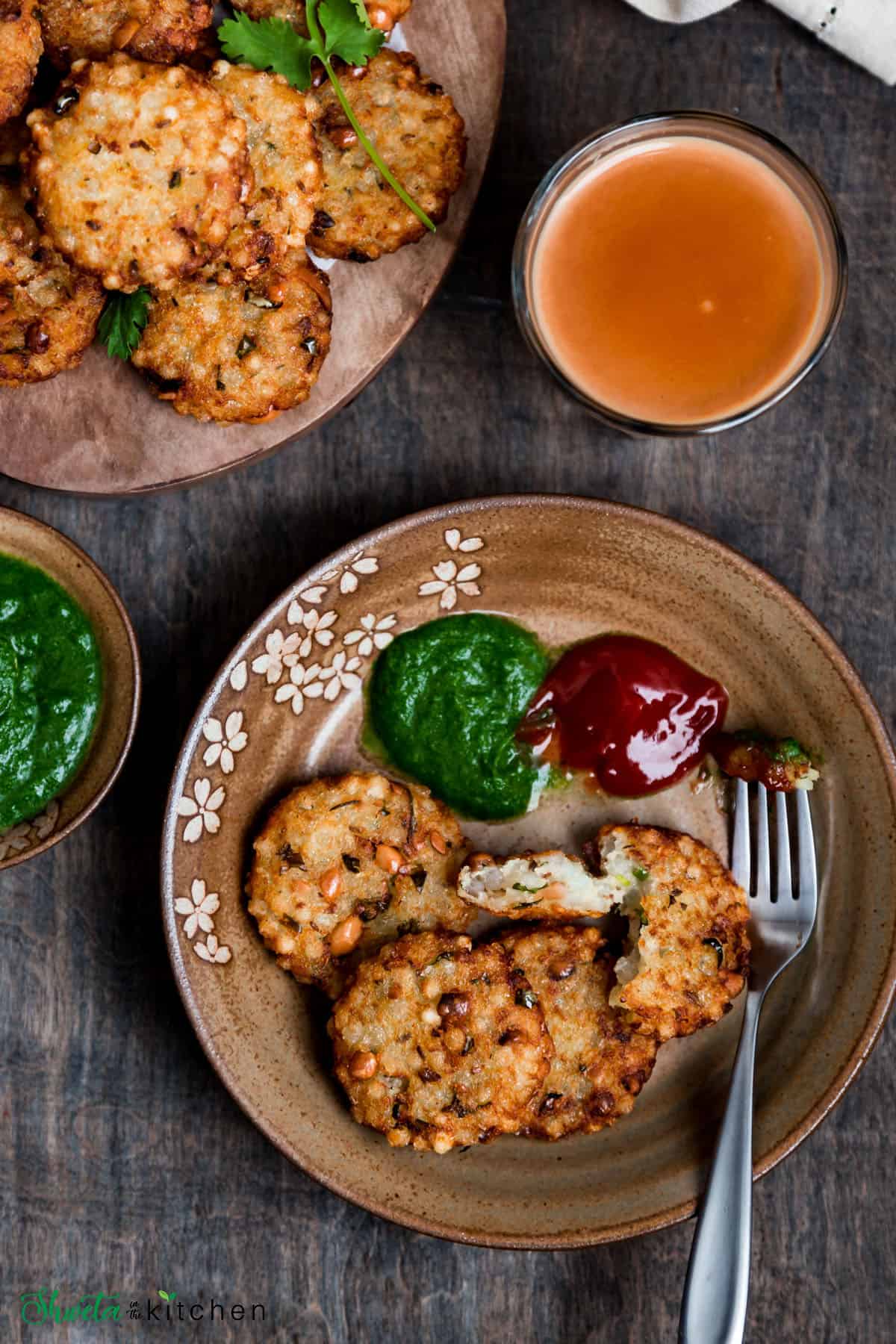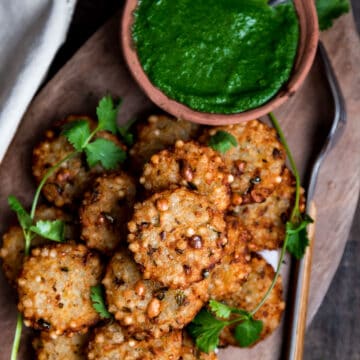Traditionally, the sago vada is deep-fried but I’m also sharing how to make sabudana vada recipe in less oil using Air-fryer, appe pan, pan-fried, and oven-baked methods. Do you love Sabudana Vada but don’t make it often to avoid deep-frying? I have great news for you!! You can now make crispy sabudana vada recipe without frying using an air-fryer, oven, or in an appe pan.
Presenting Maharashtrian style fail-proof recipe of Sabudana vada that will give you crispy and delicious Vadas!! Read all the tips to make them perfect every single time. Check these other Sabudana recipes, Sabudana Khichdi, and Sabudana Kheer also consumed during the fasting season of Navratri.
About Sabudana Vada
Sabudana Vada is a popular Indian snack recipe from Maharashtra. Its also widely consumed in other parts of India during fasting and festive occasions like Mahashivratri, Ekadashi, Sankashti, and Navratri. These crunchy on the outside and soft inside sago fritters are also popular street food in Mumbai and Maharashtra, served in restaurants and by street-side vendors. Sabudana Vada is made of three main ingredients, soaked sabudana (tapioca pearls/sago), boiled potatoes, and roasted crushed peanuts along with other herbs and spices. All ingredients are mixed together to form a dough, shaped into patties(tikki) or balls and then deep-fried (traditionally), pan-fried, baked, or air-fried. These crispy, tasty, and fluffy sago vadas make an excellent breakfast or tea-time snack with yogurt, spicy Green Chutney, Ketchup, and hot chai (tea). Let’s see how to make crispy sabudana vada and what we need to make them.
Recipe Ingredients
Sabudana: This is the main ingredient, also known as sago or tapioca pearls. Use good quality regular sabudana (sago pearls) available in most Indian grocery stores. Depending on the quality of your sabudana the soaking time will vary. So experiment with a few varieties till you find the one that works best for you. See the tips below for the perfectly soaked sabudana. Potatoes: We will use boiled mashed potatoes for this recipe. They help bind the mixture together. Peanuts: I’ve used raw peanuts with skin which I roast, peel, and then crush. To quicken the process, you can prep the peanuts ahead of time or buy the already roasted unsalted peanuts. If you are allergic, you can make without peanuts but otherwise highly recommend adding peanuts. Spices and seasonings: I only use cumin seeds (zeera), salt (sendha namak), sugar, and green chilies. These are the basic spices safe to be consumed during fasting (vrat/upvas). Rice Flour: This helps make the vadas crispy as well as soak any moisture left. This is optional and can be used during non-fasting days. Replace with Kuttu ka atta (buckwheat flour) when making for fasting. Others: Lemon juice and cilantro leaves provide the finishing touches. I use cilantro only during non-fasting days. Oil: I use peanut oil for frying. Please refer to the recipe card for exact measurements of ingredients.
How to make Sabudana Vada (Stepwise Photos)
Soaking Sabudana
1 - Rinse the sabudana well (4-5 times) till water runs almost clear. This is important to get rid of all the starch. 2 - Soak sabudana in 3 cups of water in a wide bowl for about 2-4 hrs. Cover and keep aside in a cool dry place. The amount of soaking time will vary based on the kind of sabudana. Some soak faster than others. 3 - Once soaked, they will double in size and become fluffy. Check if sabudana is soaked well. Press the soaked tapioca pearls between your thumb and index finger. It should mash easily and there should be no hard center. If they have a hard center soak for another 1 hour and check. Improperly soaked sabudana (with a hard center) can burst in oil so it’s important to soak the sabudana well. 4—Using a sieve or colander, drain the sabudana completely and let them sit until we prep the rest of the ingredients. You can also spread them on a paper towel to dry out excess moisture. Moist sabudana will make vada soggy and soak up oil, so don’t rush this process.
Boiling Potatoes
You can boil potatoes using Instant Pot, a pressure cooker, or one in a pot on the stovetop. Cook potatoes until they are fork-tender and not too mushy. Overcooking will make them soggy. Allow to cool slightly and while they are still warm, peel the skin off and mash. Warm potatoes mash easily.
Roasting peanuts
5 - Roast the peanuts in a heavy pan on medium-low heat stirring intermittently until they are golden and crispy. Keep a close watch or else the peanuts can burn and turn bitter. 6—Roast until the skin is slightly charred. Pick one peanut, cool it, and test it to see if it’s crunchy with no rawness in the center. Turn off the heat when it is ready. 7 - You can transfer them to a plate to cool or leave them in a pan and stir intermittently so they don’t cook up further from heat. Once they have cooled completely, peel the skin off by rubbing between your palms. 8—Crush the roasted peanuts to a coarse consistency (powder and peanut bits) using a mortar and pestle or food processor. Set them aside.
Make Sabudana Vada Mixture
9 - In a large mixing bowl, add all of the ingredients: boiled mashed potatoes, soaked and well-drained sabudana, coarsely crushed peanuts, rice flour, cumin seeds, salt, sugar, coriander leaves (cilantro), lemon juice, green chilies (optional). 10—Mix using your hands or a spoon so everything is well combined, like dough. Taste and adjust salt, sugar, and lemon juice as needed. 11 - Divide the dough into 20-25 equal portions. You can shape them round (like balls) or flatten them like patties 12 - To shape the sago patties, apply some oil to your palms (to prevent the dough from sticking), roll these between your palms to make a smooth ball, and then flatten to shape the patties as shown. If there are any cracked edges, seal and smoothen them. Place them on a parchment-lined plate. Don’t make the vadas too thin or too thick. Thick vadas will cause the center to remain uncooked and thin vada might get too crunchy or break. You can shape this sago vada ahead of time and store it in an airtight container in the fridge or freezer, without frying. Cook the sabudana vada using one of the methods below.
Traditional Deep Frying Method
13 - Heat oil on medium heat in a pan or wok for deep frying the sabudana vada. Test by dropping a small portion of the dough in the oil. It should rise steadily to the top. This indicates the oil is at the right temperature for frying.
If the dough breaks in oil, this indicates there is moisture. To reduce the moisture, either add more rice flour (kuttu ka atta while fasting) or boiled potatoes. Mix well, test again in oil, and shape them.
14 - To fry the vadas, gently slide 2-4 vadas in the hot oil. Fry on medium heat without overcrowding the pan. When one side is lightly golden, turn them over gently. Do not turn them before or they may break-in oil. Fry until both sides are golden and crispy.
15 & 16 - Remove the fried sabudana using a slotted spoon to drain the oil and transfer it on a plate lined with a paper towel to absorb the excess oil. Complete frying the rest of the vadas in a similar manner. Ensure the oil temperature is not too hot between batches. Deep-fried sabudana vada is ready!!
Shallow frying
You can shallow fry the sabudana vada in a skillet/pan or use paniyaram / ebelskiver / appe pan. For pan shallow frying - Heat oil on medium heat and place the vadas without overcrowding the pan. Flip once the bottom is golden and cook the other side until golden too. Drain and remove on a plate lined with a paper towel. For the appe pan, shape the sabudana vada round, add few drops of oil in each round. Cook one side until golden and crispy and then use skewers to flip. Add a few drops of oil between flipping as needed. Cook until all sides are golden and crispy. Remove on a plate lined with a paper towel. Crispy sabudana vada in appe pan is ready!!
Air frying and Baking Method
Place the Sabudana Vadas in the air fryer basket (7-8 without overcrowding), spray/brush some oil (optional), and air-fry at 370°F-400°F for 12-15 mins, flipping it halfway through. The first batch may take a little longer, about 15 minutes, but the consecutive ones should be quicker, around 12 minutes. The time may vary slightly depending on your air fryer. Crispy Air-Fried Sabudana Vada is ready!! Similarly, you can also bake sabudana vada. Place them on parchment paper and spray with oil. Bake at 400°F for 30 to 35 mins until crispy and golden on both sides. Flip halfway through. Depending on your oven, the time may vary slightly.
Serving Suggestion
Sabudana Vada is best served immediately while it’s hot and crispy. So, to get the best taste experience, prep the vada ahead of time, shape it, and store it in the fridge or freezer. However, fry it just before serving. Serve them with a side of Green Chutney or tomato ketchup and hot chai (tea) for that perfect breakfast or tea-time snack. During fast, you can serve this vada with farali chutney or a side of sweetened yogurt (curd).
Storage Instructions
You can make the sabudana vada mixture ahead of time, shape and store uncooked sabudana vada (tikkis) in the fridge for a couple of days or freeze for longer use.
To store in the fridge, line a glass container with parchment paper. Arrange the vada in a single layer. Separate each layer with parchment paper to prevent the vada from sticking.
To freeze, line them on a tray, and once frozen transfer them to a ziplock bag and store them in the freezer. Thaw completely before cooking. Dab with a paper towel if there is any moisture to prevent the oil splatter.
Leftover cooked sabudana vada can be stored covered in the fridge for a couple of days. It can be reheated in the microwave (it will turn out soft) or air-fried at 350°F for 3-5 mins or until hot and crispy.
Recipe Tips
Soaking Sabudana: The soaking time can vary depending on the variety of sabudana. Some soak in 2-4 hours, while some might need longer. So experiment with your variety. Soak your sabudana until it’s double in size, fluffy, mashes easily, and has no hard center. Improperly soaked sabudana can burst in oil and also make vada hard and chewy, so make sure to soak them well. Drain Sabudana well: Drain the water completely using a sieve or colander. If sabudana feels wet, dry them on a paper towel. Wet sabudana can cause moisture in the vada making them soggy. Excess moisture in the vada can cause them to break in oil or soak more oil. Boiled potatoes: Overcooking the potatoes will make them mushy and boiled potatoes with too much moisture will make the Vada soggy. Boil potatoes until they are fork-tender. When done right, boiled potatoes help to bind the vada together and prevent them from breaking. Mash the potatoes while they are warm for an easier and smoother consistency. Roasted peanuts: Use roasted unsalted peanuts to cut down on roasting time. I prefer to crush them coarse such that it’s a mix of peanut powder and bits. That way the powder helps absorb any moisture and the bits provide the crunch. You can also make it all powder. Oil Temperature: Fry the vada on medium heat. Frying them on high heat will make them brown quickly keeping the inside center undercooked. Frying them on low heat can cause the vada to break or make them oily as they will absorb oil. So it’s important to fry at the right temperature. Always test the oil temperature with a small dough portion. The dough should rise to the top gradually not too slow not too fast. Add flour - I prefer to add a little rice flour to the Sabbudnaa vada. It helps bind the mixture and absorb moisture which prevents the vada from breaking. You can also use Kuttu ka atta or rajgira flour while fasting. Leftover sabudana khichdi to make sabudana vada: mix the leftover khichdi with boiled potatoes, coriander leaves, adjust salt, sugar lemon juice, and green chilies to make the vada mixture. Shape and fry as usual.
Variations
With Sweet Potato - You can swap potatoes with sweet potatoes but that will result in sweeter sabudana vada With Onion - Generally in the authentic Maharashtrian sabudana vada recipe onion, ginger and garlic are not used but you can definitely experiment and add it to the vada mixture. Spices - traditionally sabudana vada uses simple ingredients and not too many spices. But during days when you are not fasting, you can add a pinch of turmeric powder or ½ teaspoon of red chili powder if you like it spicier.
More Indian Snacks
Hope you enjoy Sabudana Vada Recipe!! If you give this recipe a try, please rate by clicking stars ⭐️ in the recipe card. Thank you ❤️! You can also follow me on Facebook | Instagram to see what’s cooking in my kitchen!!
Recipe Card
Update Notes: This post was originally published on Apr 11, 2017, but was republished with, step by step detailed instructions, and tips in Oct of 2021.
